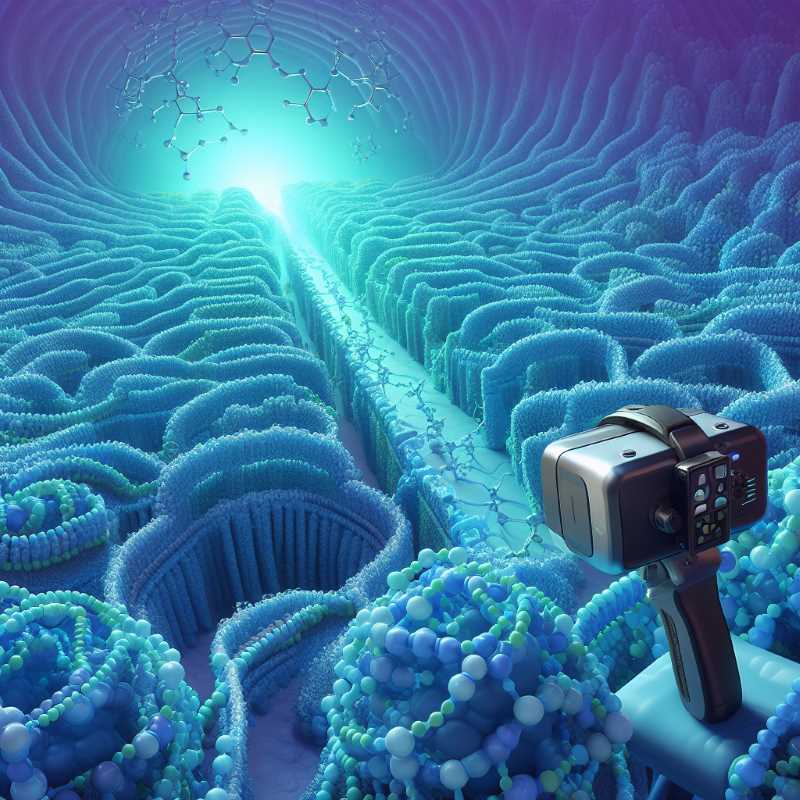Inside the Mind-Bending World of Microscopic VR Science
From cells to pipelines, VR unlocks the secrets of atoms. Biophysics meets sci-fi as researchers use virtual reality to design custom medicine, tame icy gas giants, and revolutionize oil extraction.

Imagine shrinking yourself down to the scale of atoms, where the laws of physics morph into a bizarre quantum leaps and fleeting interactions. This is the realm Humberto Saint-Martin Posada and his team at the Institute of Physical Sciences (ICF) of UNAM explore, not with microscopes, but with the fantastical tools of virtual reality. Their playground? The Theoretical Studies of Aqueous Solutions and Coexistence of Phases project, a mind-bending fusion of virtual worlds and cutting-edge science with applications that could revolutionize medicine, oil extraction, and our understanding of the universe itself.
Saint-Martin, a biophysicist and materials scientist, delves into the complexities of this microscopic realm. He speaks of electronic transitions that take place in femtoseconds (a millionth of a millionth of a second!), and biological phenomena that unfold on the nanoscale, like the elusive formation of lipid rafts in cell membranes. These are the hidden gears that drive life and industry, and understanding them is key to unlocking new possibilities.
One such possibility lies in the realm of drug delivery. Imagine tiny, tailor-made molecules, guided by the insights gleaned from VR simulations, navigating the labyrinthine pathways of our cells, delivering their precious payloads with pinpoint accuracy. This is no longer science fiction; it's the future Saint-Martin and his team are actively shaping.
But their VR toolkit isn't just for biology. Take the methane hydrates lurking in the icy depths of the ocean, potential fuel sources trapped in a cage of their own making. These gas hydrates, akin to nature's icy plumbing nightmares, can clog pipelines and pose serious safety risks. Enter the VR heroes. By simulating the formation of these icy demons, Saint-Martin and his team have discovered a way to combat them – zapping them with gigavolts of electricity. Talk about shocking the system.
But VR isn't just about brute force; it's about finesse. Before unleashing the electrical cavalry, the team can test different antifreeze options in their virtual playground, saving time, money, and potentially a few exploding pipelines. This virtual testing ground allows them to design a custom-made antifreeze strategy, guiding Petróleos Mexicanos, the Mexican national oil company, towards the most efficient and cost-effective solution.
The beauty of this VR approach lies in its versatility. It's like a universal translator for the language of the microcosmos. From the delicate movement of atoms in an aqueous solution to the burly handshake of methane molecules forming a hydrate, the team can tailor their simulations to any chemical or physical phenomenon. Quantum mechanics? No problem. Classical mechanics? Piece of cake. VR lets them switch gears effortlessly, navigating the diverse terrain of the microscopic world with the agility of seasoned explorers.
Saint-Martin's infectious enthusiasm is palpable as he talks about the future. He envisions a world where VR isn't just a tool for scientists, but an educational playground for students and the public alike. Imagine stepping into a virtual world where you can witness the birth of a protein molecule or watch a methane hydrate form in real-time. This democratization of science, Saint-Martin believes, is key to fostering a deeper understanding and appreciation for the invisible forces that shape our world.
So, the next time you look up at the vast expanse of the universe or down at the tiny blade of grass beneath your feet, remember the unseen world teeming with possibilities. Remember the intrepid explorers like Saint-Martin and his team, armed with their VR headsets, venturing into the microverse, not just to understand, but to shape the future.




